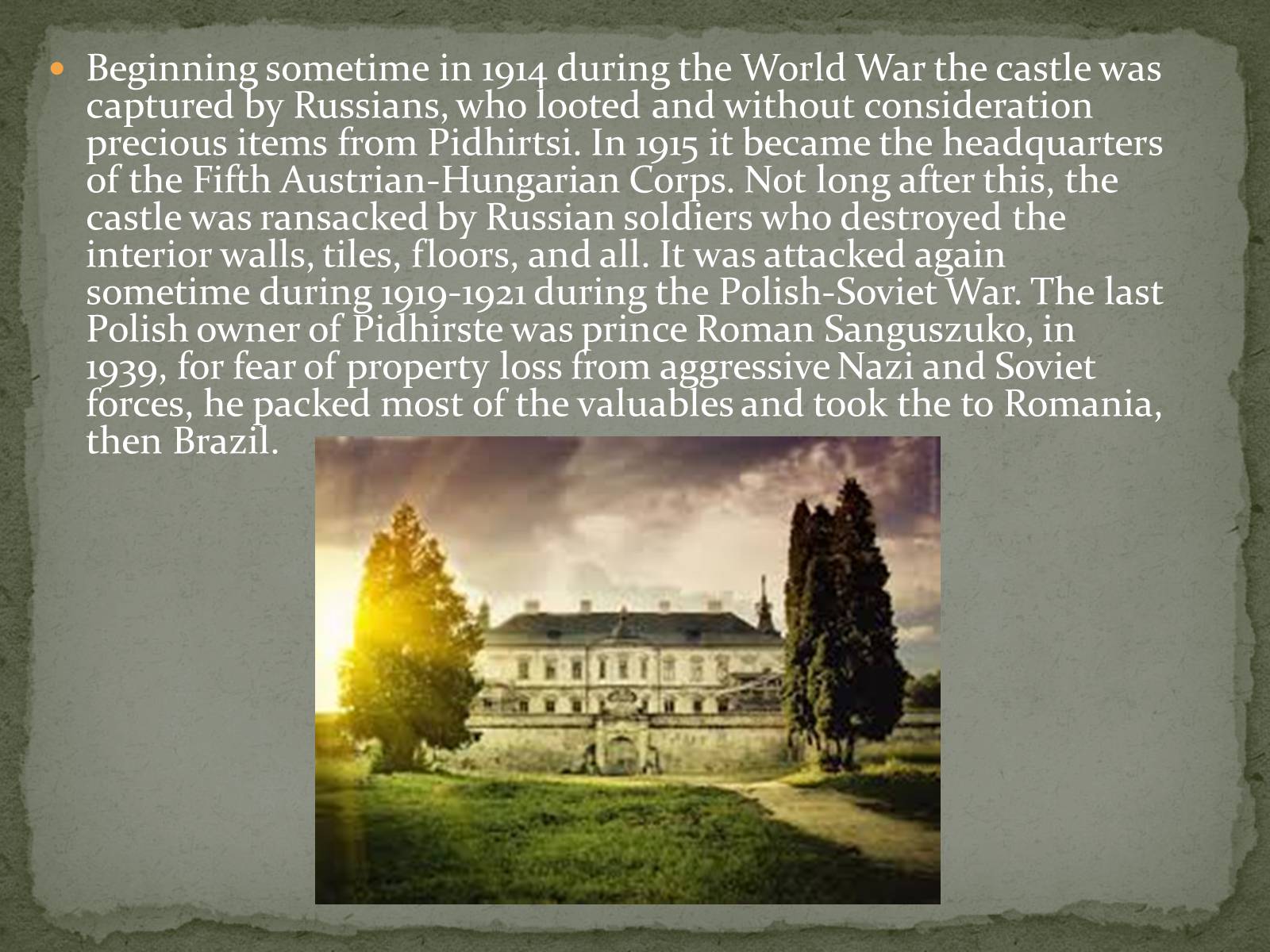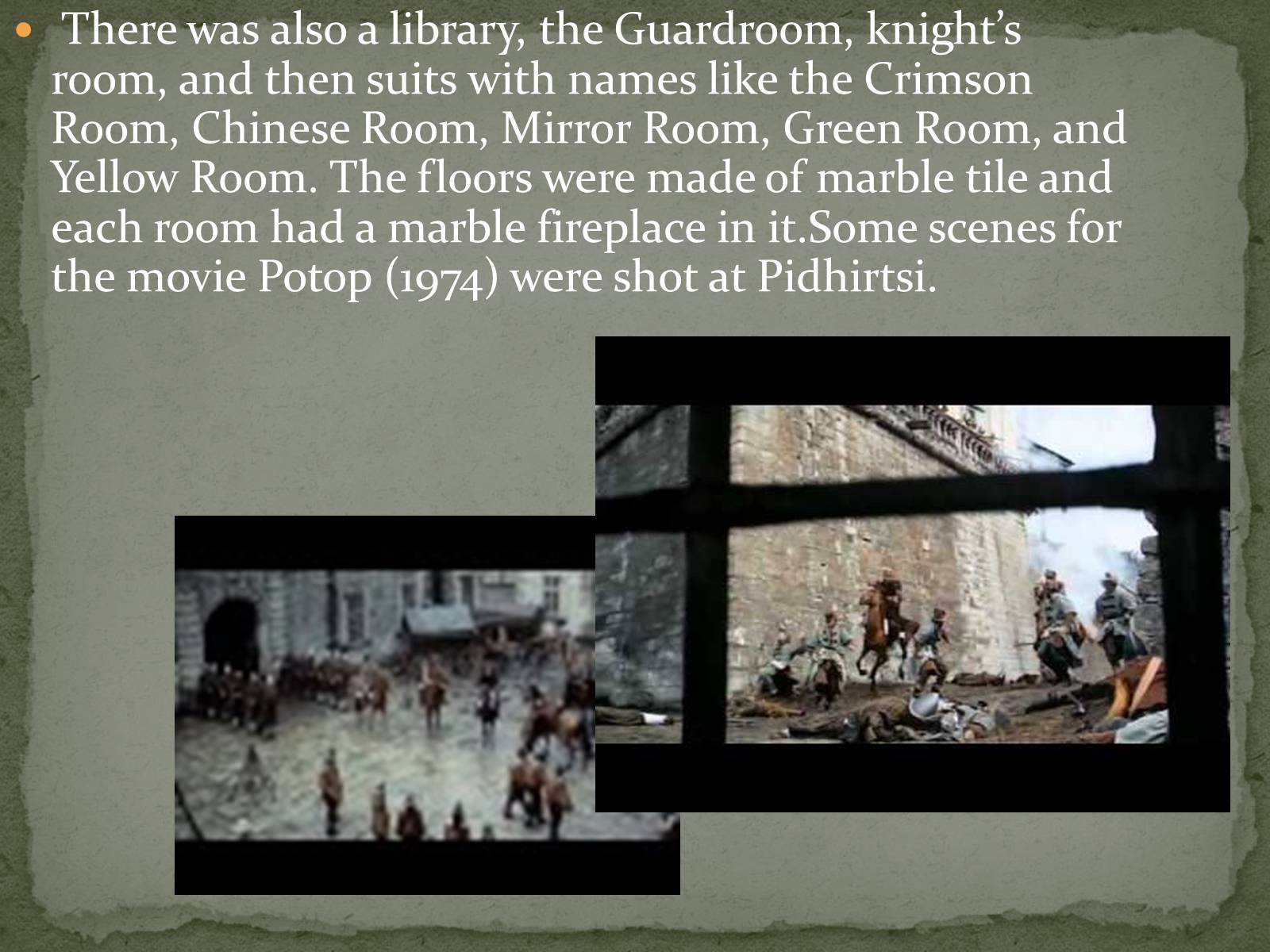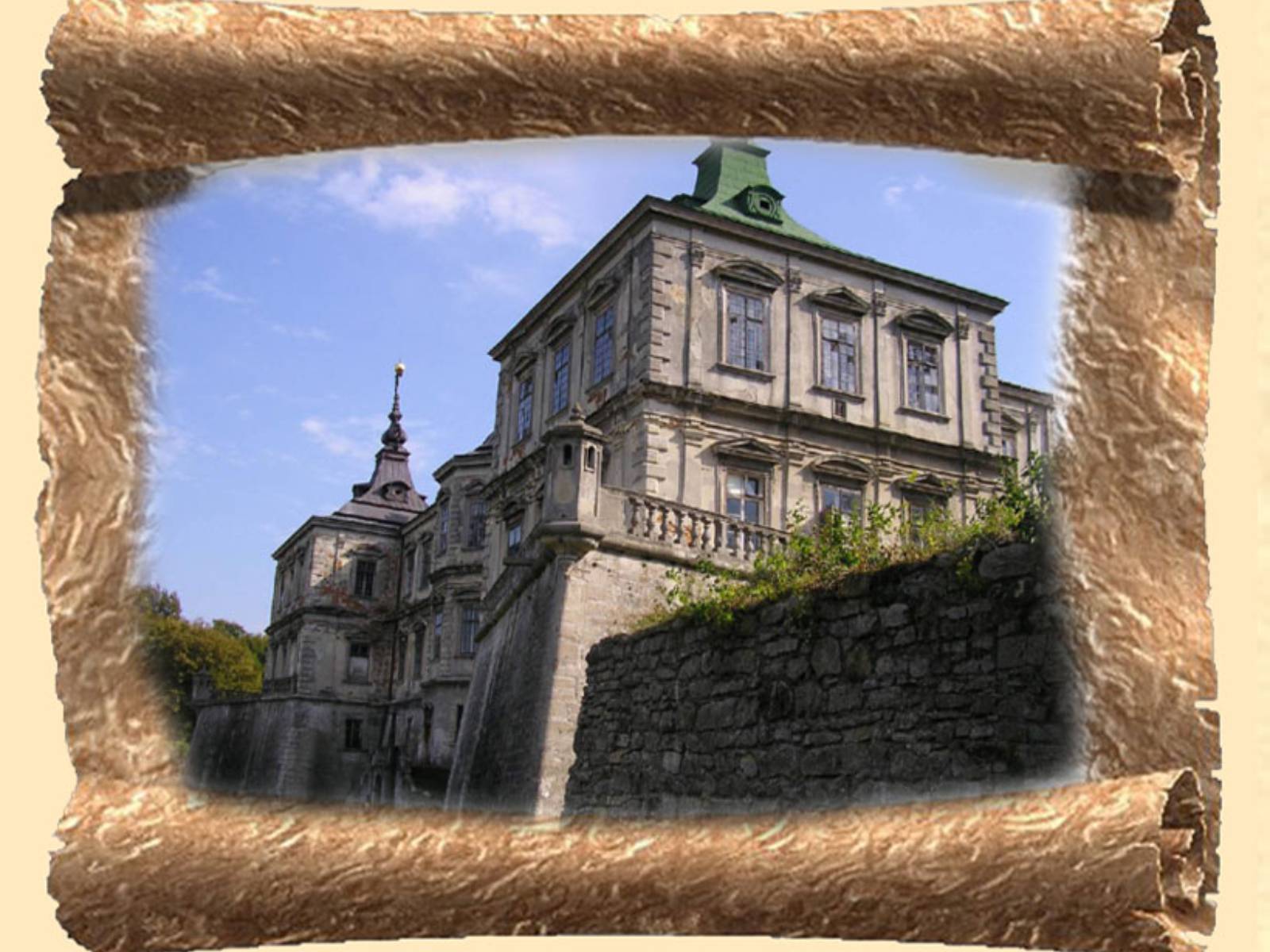- Головна
- Готові шкільні презентації
- Презентація на тему «Pidhirtsi»
Презентація на тему «Pidhirtsi»
371
Слайд #1
Pidhirtsi

Слайд #2
Pidhirtsi Castle (Ukrainian: Підгорецький замок; Polish: zamek w Podhorcach) is a residential castle-fortress located in the village of Pidhirtsi in Lviv Oblast (province) western Ukraine, located eighty kilometers east of Lviv.

Слайд #3
It was constructed by Guillaume Le Vasseur de Beauplan between 1635–1640 by order of the Polish-Lithuanian Commonwealth's Grand Crown Hetman Stanisław Koniecpolski, on the place of the older fortress. The castle was then part of the Kingdom of Poland and it is regarded as the most valuable of palace-garden complexes in the eastern borderlands of the former Polish-Lithuanian Commonwealth.

Слайд #4
The structure, built with brick and stone, was designed in the characteristic palazzo in fortezza style. It is located on the northern side of the Woroniaki hills, standing at 399 meters above sea level, overlooking the Styr River valley, in a prominent location where it can be seen from great distances. The palace itself is built into the slope of the hill. In the 17th century, it was surrounded by vineyards and Italian-style paterre gardens, its wine celebrated by the poetry of Jakub Sobieski and Andrzej Morsztyn. Guarded by a moat and drawbridge, fortified walls with bastions and a set of iron cannons .

Слайд #5
The castle takes the form of an open square nearly 100 meters on a side, with three floors.
Its western part served as an official residency for guests; the eastern range was private, reserved for the owner and servants. Above the entrance gate, a marble plaque to this day bears a Latin inscription: "A crown of military labours is victory, victory is a triumph, triumph is rest." There also was a grange, a private zoo, vineyards, an apiary, a trout pond and a mill.
Its western part served as an official residency for guests; the eastern range was private, reserved for the owner and servants. Above the entrance gate, a marble plaque to this day bears a Latin inscription: "A crown of military labours is victory, victory is a triumph, triumph is rest." There also was a grange, a private zoo, vineyards, an apiary, a trout pond and a mill.

Слайд #6
Beginning sometime in 1914 during the World War the castle was captured by Russians, who looted and without consideration precious items from Pidhirtsi. In 1915 it became the headquarters of the Fifth Austrian-Hungarian Corps. Not long after this, the castle was ransacked by Russian soldiers who destroyed the interior walls, tiles, floors, and all. It was attacked again sometime during 1919-1921 during the Polish-Soviet War. The last Polish owner of Pidhirste was prince Roman Sanguszuko, in 1939, for fear of property loss from aggressive Nazi and Soviet forces, he packed most of the valuables and took the to Romania, then Brazil.

Слайд #7
After World War II, the Soviets oped the sprawling castle into a Tuberculosis sanitarium. In February of 1956, the castle caught on fire and was almost completely destroyed. It burnt for 3 weeks leaving $2 million in damages and only leaving the walls. Left in decay for sometime, when Ukraine regained its independence from the Soviet Union, it was planned for Pidhirtsi to be redone into a presidential residence. This never happened so finally, it was bought by the Lviv Gallery of Painting in 1997. They wish to turn it into a museum and give it its historical look. Though as of 2013, lack of funds have the restoration process going slow. Tourist are allowed to come onto the property but entry is forbidden. The exterior was built with brick and stone.

Слайд #8
There was also a library, the Guardroom, knight's room, and then suits with names like the Crimson Room, Chinese Room, Mirror Room, Green Room, and Yellow Room. The floors were made of marble tile and each room had a marble fireplace in it.Some scenes for the movie Potop (1974) were shot at Pidhirtsi.

Слайд #9
There was also a library, the Guardroom, knight's room, and then suits with names like the Crimson Room, Chinese Room, Mirror Room, Green Room, and Yellow Room. The floors were made of marble tile and each room had a marble fireplace in it.Some scenes for the movie Potop (1974) were shot at Pidhirtsi.

Слайд #10
There was also a library, the Guardroom, knight's room, and then suits with names like the Crimson Room, Chinese Room, Mirror Room, Green Room, and Yellow Room. The floors were made of marble tile and each room had a marble fireplace in it.Some scenes for the movie Potop (1974) were shot at Pidhirtsi.

Слайд #11
There was also a library, the Guardroom, knight's room, and then suits with names like the Crimson Room, Chinese Room, Mirror Room, Green Room, and Yellow Room. The floors were made of marble tile and each room had a marble fireplace in it.Some scenes for the movie Potop (1974) were shot at Pidhirtsi.

Слайд #12
There was also a library, the Guardroom, knight's room, and then suits with names like the Crimson Room, Chinese Room, Mirror Room, Green Room, and Yellow Room. The floors were made of marble tile and each room had a marble fireplace in it.Some scenes for the movie Potop (1974) were shot at Pidhirtsi.

Слайд #13
Church of Saint
Joseph in Pidhirtsi
Joseph in Pidhirtsi

Слайд #14
Church of Saint
Joseph in Pidhirtsi
Joseph in Pidhirtsi

Слайд #15
Church of Saint
Joseph in Pidhirtsi
Joseph in Pidhirtsi

Слайд #16
